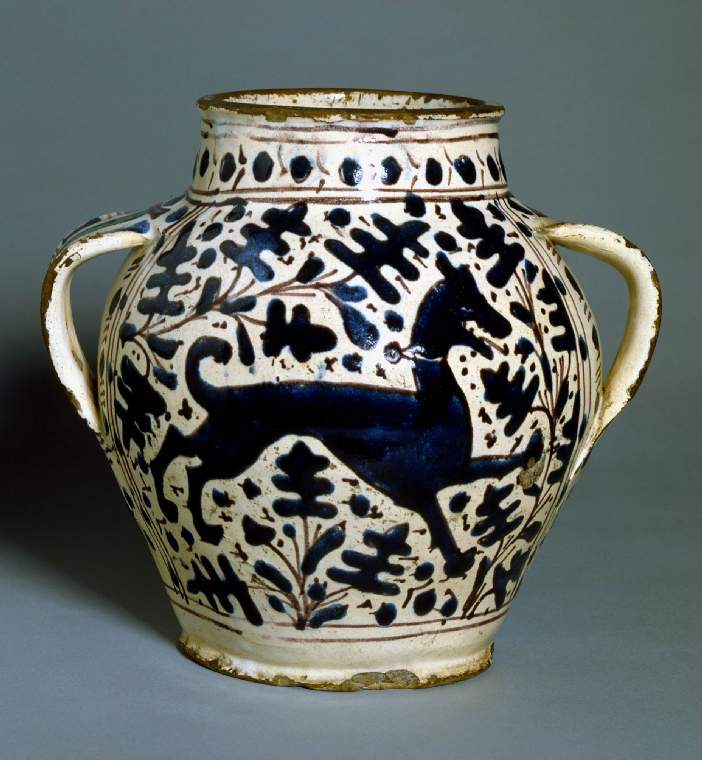Current Location: Gallery 6 (Upper Marlay): case 1, shelf C
Maker(s)
Workshop:
Giunta di Tugio
(Probably)
Workshop:
Maso and Miniato di Domenico
(Perhaps)
Entities
Categories
Description
Renaissance maiolica two-handled pharmacy jar, painted in manganese, dark relief blue and green with hounds, 'oak leaves', dots and dashes.
Buff earthenware, tin-glazed creamy-white on the interior and exterior; most of the rim and base unglazed. Painted in manganese, dark relief-blue, and a little green. Shape 42. Ovoid with flat base, short cylindrical neck and two strap handles.
On one side there is a hound running to the left and, on the other, a hound running to the right, surrounded by sprays of oak leaves with dots and dashes in the background. On each side of the handles, there are three vertical manganese lines, on the outside of which are short horizontal manganese strokes separated by blue spots. Round the lower part of the body there are two horizontal manganese bands; round the neck, alternating manganese chevrons and blue spots between pairs of manganese bands. The handles are decorated with a crutch with a green shaft, a series of horizontal manganese lines, and blue spots. Below each handle are two manganese six-armed asterisks with blue dots at the end of the strokes.
Notes
History note: Sir Otto Beit (1865-1930); Sir Alfred Beit (1903-94); Sotheby's, 16 October 1942, Catalogue of important Italian majolica, the property of Sir Alfred Beit Bt, MP., lot 5; Louis C.G. Clarke (1881-1960)
Legal notes
L.C.G. Clarke Bequest, 1960
Measurements and weight
Height: 20 cm
Acquisition and important dates
Method of acquisition: Bequeathed
(1961-04-27)
by
Clarke, Louis Colville Gray
Dating
15th Century, second quarter
Renaissance
Circa
1427
CE
-
1431
CE
Note
This jar is decorated in manganese and relief-blue (zaffera a rilievo), a glaze-like, upstanding pigment containing cobalt. Archaeological evidence recovered since 1975 indicates that it was probably introduced in Tuscany during the last third of the fourteenth century, as fragments found during excavations in Florence and nearby towns, such as Prato, Pistoia, and Montelupo, can be dated to the end of the century. Others have been found with fragments of Italo-Moresque type which suggests that relief-blue decoration continued until the 1460s.By the early fifteenth century it was well-established and in addition to two-handled jars, it was used on jugs, albarelli, ewers, and, more rarely, on dishes. It was also adopted in the Romagna, Lazio, and Umbria during the same period. It may be the blue referred to in two recipes, one for blue pigment for the decoration of maiolica, and the other for relief-blue 'in the Florentine manner' included in a MS now in the Library of the University of Bologna (MS 2861), and formerly in the convent of San Salvatore in Bologna.
The best-known examples of relief-blue decoration outside Italy are Tuscan two-handled storage jars. These have been attributed to Florence and Montelupo, and were probably made elsewhere, such as at Baccheretto. Typically they have borders creating a panel on each side which is occupied by a central motif surrounded by stylized oak foliage. The main motifs include heraldic and other animals, fleurs-de-lis, and mythical or human figures. Some jars, however, are decorated overall with foliage, scales, or undulating lines. These motifs appear to have been derived from local and Islamic art, including heraldry, woven textiles and ceramics. This is one of at least twenty-one 'oak leaf jars' whose handles bear the crutch emblem of the hospital of Santa Maria Nuova in Florence. The hospital's archives record the purchase of large numbers of jars for its pharmacy in 1427 from Maso and Miniato di Domenico. But it seems more likely that they were among about 1,000 ordered in 1431 from Giunta di Tugio, whose workshop was in the Oltrarno district of the ciity, because the record mentioned orciuoli (two handled jars) for the new pharmacy. The meaning of the two asterisks is uncertain. They may be the mark of a decorator, because one, two or three asterisks occur on other jars of this kind. An excavation in 1975 on the site of the Giunta di Tugio's workshop in Florence confirmed that maiolica with relief-blue decoration was made there and that an asterisk mark was used, and this was confirmed by a further excavation in 2015.
School or Style
Renaissance
People, subjects and objects depicted
Components of the work
Decoration
composed of
high-temperature colours
( manganese, dark relief-blue, and a little green)
Mouth
Diameter 11.3 cm
Base
Diameter 11.8 cm
Across Handles
Width 22.5 cm
Body
Materials used in production
most of rim and base unglazed
Tin-glaze
Earthenware
Techniques used in production
Tin-glazing
Inscription or legends present
Inscription present: circular with serrated edge, 62 crossed out
- Text: 62
- Method of creation: Inscribed in pencil
- Type: Label
- Text: 736
- Location: On base
- Method of creation: Inscribed in red
- Type: Mark
References and bibliographic entries
Related exhibitions
Identification numbers
Accession number: C.75-1961
Primary reference Number: 81370
Stable URI
Audit data
Created: Saturday 6 August 2011
Updated: Tuesday 13 August 2024
Last processed: Wednesday 14 May 2025
Associated departments & institutions
Owner or interested party:
The Fitzwilliam Museum
Associated department:
Applied Arts




